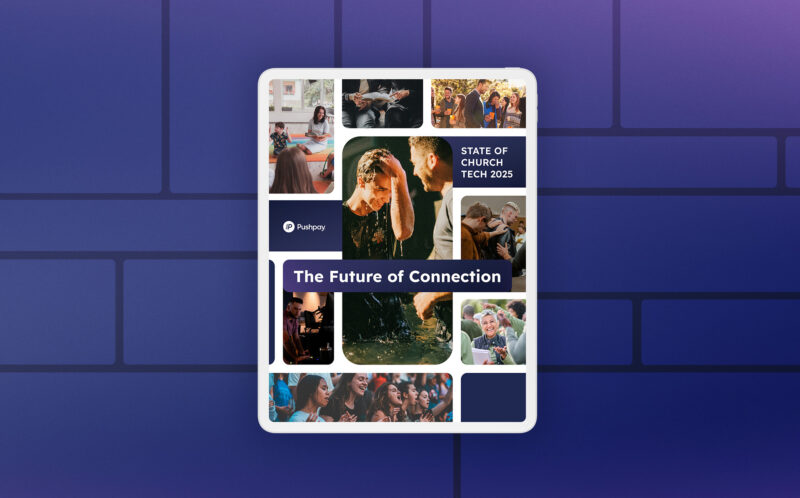
What Amazon’s Sales Statistics Mean for Mobile Giving
The rise of mobile technology has had huge implications on society; not offering a solution for mobile giving can hinder church generosity.
Amazon, the online retail giant, has over 304 million active user accounts and almost 193 million unique monthly visitors. So it’s important to note that 60 percent of Amazon’s sales in 2015 were from mobile devices. Churches need to wrestle with the implications of this statistic.
Mobile technology is changing the way people engage, bank, communicate, and browse the web. Think about the following facts:
- On average, Americans spend 2.95 hours on their phone a day, and only 2.8 watching television.
- People spend an average of 34 hours a month using the internet from a smartphone, but only 27 hours on a laptop or desktop.
- $100 billion dollars will be spent on mobile advertising in 2016—more than 50% of the digital market.
Mobile technology is inevitable, and businesses have been preparing for this inevitability for some time. Some churches have made concessions with mobile engagement but are extremely hesitant to give up the old wineskin of passing offering plates.
It’s the church’s job to help people grow in spiritual maturity, and part of that goal involves teaching people to be generous and faithful givers. In pursuit of that goal, we can’t be hesitant to eschew models and practices that no longer work. We need to be reaching people in the culture they’re in and using the tools they use every day.
4 Risks of Not Going Mobile
Imagine if a business like Amazon had decided five years ago not to prioritize mobile engagement with their customer base. Sure, some of 60 percent of their mobile sales would have still been made from a computer, but not all of them. Eventually, most of those people would have moved on to a shopping experience that made more sense to them.
It’s time for churches to begin thinking through the risks of ignoring or marginalizing a mobile-engaged culture. What is potentially lost if the church doesn’t pivot with this cultural change? This:
1. We make it harder for people to become spiritually mature
It’s hard enough to teach people to become sacrificial givers. If we’re unintentionally setting up obstacles between generous giving and our congregation, we’re just making it harder. To expect them to give in the manner that we’ve become accustomed to (despite the fact that it makes it harder on us, too), does them a disservice.
Consider these statistics about Millennials (those born between 1981–2005):
- Over 20% of them have never written a check to pay a bill.
- 63% of them don’t own a credit card.
- 94% of people under 35 use online banking.
To expect them to adopt old models of giving in order to become spiritually mature is a losing proposition. Not only do churches need to embrace mobile giving, they need to start preferring it.
2. You’re limiting your giving to a Sunday-morning window
It’s Wednesday morning and Sandra is reading an article about generosity. It’s really convicting her. She decides to make a contribution to the church’s benevolence fund. She reaches down, picks up her phone, and uses your church app to make an instant donation above and beyond her normal giving.
Oh, you don’t have a church app? Well, maybe she’ll write a check, but probably not—she hasn’t touched her checkbook in months. Hopefully, this conviction is still there on Sunday.
There are 168 hours in a week. Why limit people to a 10-minute giving window on Sunday morning?
3. You’re limited to Sunday-morning attendees
Imagine your church is doing a drive to raise money for someone in your church with cancer. One of the people who attends brings it up in their book club. A couple people in the club are enthusiastic about helping out, and pull out their phones, down/load your church app, and give in minutes.
There are lots of reasons that people might not regularly attend your church (or attend at all), but they still might be open to contribute to your vision. Why not make it as easy as possible?
4. If it’s not easy to give to you, people will give to others
Back to the question I used to open this section: What if Amazon had decided five years ago not to prioritize mobile engagement with their customer base? They would have lost a lot of business because people would be driven to make decisions based on what is most expedient for them.
There is a bagelry that I love in my city, but they don’t accept debit cards. If I have cash and I’m hungry, I’ll stop in for a bite. But I’ve never withdrawn cash to go eat there. If I’m in town, nine out of ten times I’ll go somewhere I enjoy less because they make it easier for me to pay.
You Need to Go Mobile—We Can Help!
It’s naive to think that people will give to you because they’re aligned with you—no matter what hoops you make them jump through. There is no lack of churches or charities that people can identify with and contribute to. Your congregants might be incredibly generous, and chances are that they’re going to make donations to the ministries and charities that make it easy for them. Why make it harder than it needs to be?





